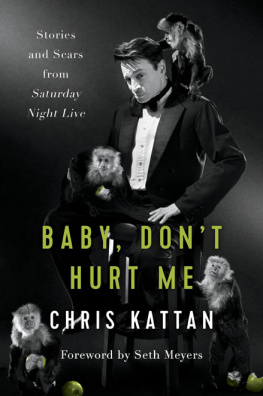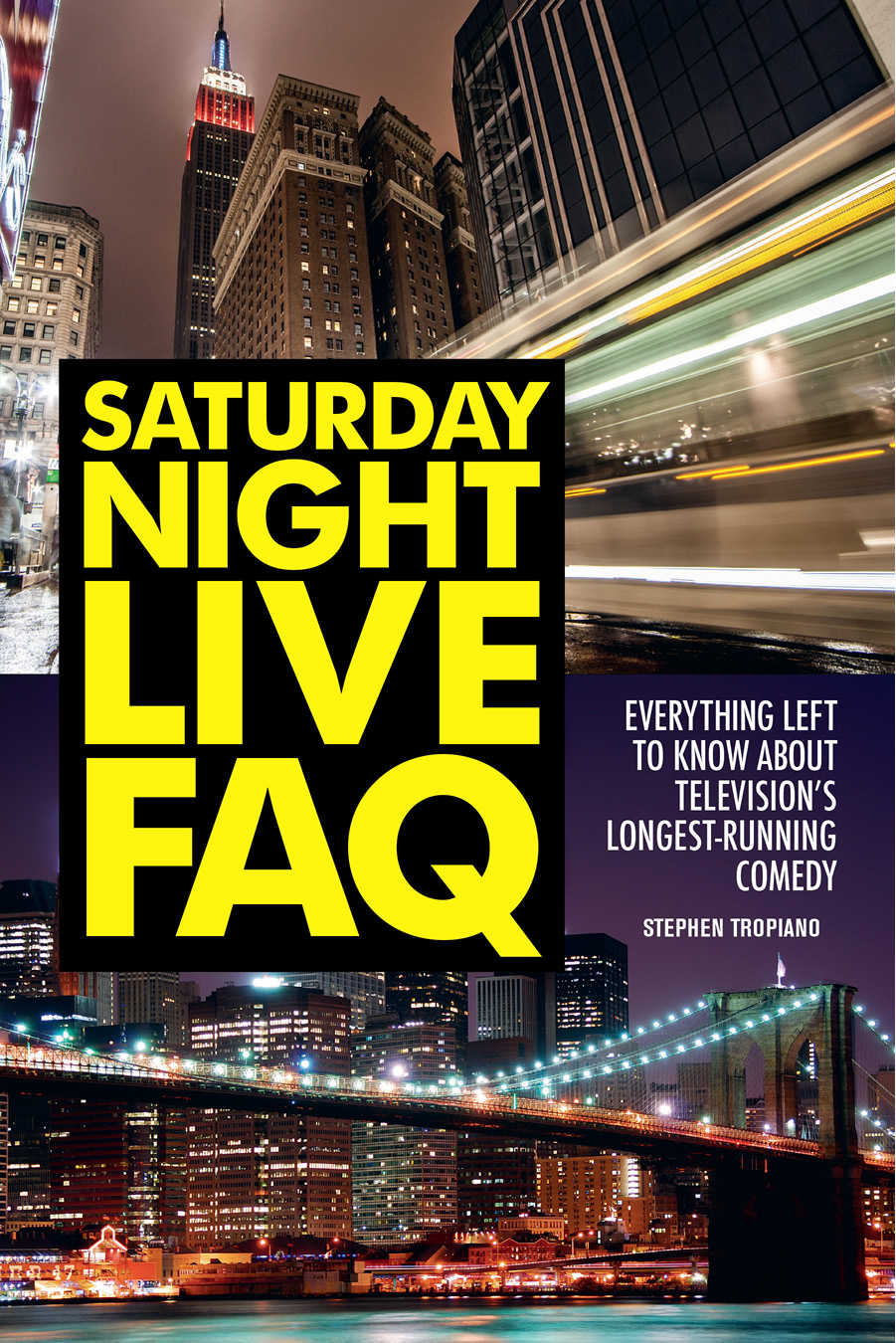Copyright 2013 by Stephen Tropiano
All rights reserved. No part of this book may be reproduced in any form, without written permission, except by a newspaper or magazine reviewer who wishes to quote brief passages in connection with a review.
Published in 2013 by Applause Theatre & Cinema Books
An Imprint of Hal Leonard Corporation
7777 West Bluemound Road
Milwaukee, WI 53213
Trade Book Division Editorial Offices
33 Plymouth St., Montclair, NJ 07042
Images are from the authors personal collection except where stated otherwise.
The FAQ series was conceived by Robert Rodriguez and developed with Stuart Shea.
Printed in the United States of America
Book design by Snow Creative Services
Library of Congress Cataloging-in-Publication Data
Tropiano, Stephen.
Saturday night live FAQ : everything left to know about televisions longest-running comedy / Stephen Tropiano.
pages cm
Includes bibliographical references and index.
ISBN 978-1-55783-951-0
1. Saturday night live (Television program) I. Title.
PN1992.77.S273T76 2014
791.4572dc23
2013038849
www.applausebooks.com
To my older brothers, Michael and Joseph,
who stayed up with me to watch SNL in the 70s;
to Steven Ginsberg, who has been watching SNL
with me for the past twenty-six years;
and to Lorne Michaels, for giving all of us
something to do on Saturday night
Contents
One very cold Saturday afternoon in January 1978, a week after my sixteenth birthday, my brother Joe and I took a train from Croton-on-Hudson, New York, into the city to watch a rehearsal of Saturday Night Live . The tickets I mailed away for a year before were for the 8:00 p.m. dress rehearsal, which meant we could take the 10:00 p.m. train back home to see the live broadcast of the show at 11:30 p.m. (The Tropiano family didnt get their first VCR until 1982.)
I had never been in a television studio before, nor had I ever seen a television star in person. I also remember being nervous because No one under seventeen will be admitted was printed on the ticket. Fortunately, no one was paying very close attention, and after waiting for two hours in the halls of 30 Rockefeller Center, the NBC pages ushered us into the balcony of Studio 8H.
We lucked outseason 3, episode #10 was great. Comedian Robert Klein was the host, and Bonnie Raitt, who at the time I only knew as the daughter of Broadway star John Raitt, was the musical guest (she sang Runaway and Give It All Up or Let Me Go with Klein on the harmonica). The original cast members were all there (minus Chevy Chase, plus Bill Murray). We saw the first Olympia Caf sketch (Cheezburger, Cheezburger, Cheezburger) and the debut of nerds Lisa Loopner (Gilda Radner) and Todd DiLaMuca (Murray), and heard Nick the Lounge Singer (Murray) sing the theme song from Star Wars . The episode ended with the studio being taken over by atomic lobsters. The invasion was orchestrated by head writer Michael ODonoghue, who stood with a bullhorn directing the audience to look scared even though there were no lobstersatomic or otherwisein the studio.
The following year I attended another rehearsal with my friend Heidi Jensen, whose father was a correspondent for NBC News. We entered the studio on the VIP line and sat in the first row in front of one of the tiny stages where they perform the sketches. The host was actress Margot Kidder (4.15), who played Lois Lane in the original film version of Superman (1978). The show wasnt as funny as the first, except for one clever sketch in which newlyweds Lois Lane (Kidder) and Superman (Bill Murray) are throwing a party, and she is concerned her friends wont mix with his friends, who are all superheroes, like the Flash (Dan Aykroyd) and the Incredible Hulk (John Belushi).
As we were exiting the studio, members of the cast were milling around thanking the audience. As we passed by John Belushi, who had a scowl on his face, the comedian said, You should have laughed more. He wasnt talking directly to me, but without thinking I replied, It should have been funnier. Belushi looked at me and flashed me a smile.
Saturday Night Live is one of the reasons I entered college as a television and radio major. Four degrees and many years later, I am now teaching television studies to undergraduates who are pursuing careers in television and film. As I grow older and the generation gap between my students and me widens, it has become increasingly more difficult to explain why Saturday Night Live was considered groundbreaking when it debuted on October 11, 1975. I imagine its like Woodstock. The people Ive met who were there (and can actually remember being there) say you had to have been at Woodstock and experienced it for yourself to fully understand why it was a milestone in our cultural history.
Saturday Night Live s contribution to American culture and, more specifically, American comedy, is immeasurable. I never imagined back when I was a teenager sitting in Studio 8H that thirty-eight years later I would not only still be watching SNL but writing a book about the show. For this opportunity, I am truly grateful.
Stephen Tropiano
Los Angeles, California
Twitter: @StephenTrop
Thanks to everyone in my personal and professional life for their support and encouragement to take on this project: Christine Tucci Angell, Linda Bobel, Sylvia Borchert and Deborah Silberberg, Jon Bassinger-Flores, Diane Gayeski, Faith Ginsberg, Gary Jones, Elisabeth Nonas, Jackie Paul, Barry Sandler, Neil Spisak, Arnold Stiefel, Holly Van Buren, Patty Zimmermann, my friends at the Trevor Project, and my 1,695 1,582 friends on Facebook.
At Hal Leonard, a major thank-you to John Cerullo for giving me this opportunity, Marybeth Keating for her patience and support, Jessica Burr for her expertise and guidance, and Michele Eniclerico for her assistance. Thanks also to Jaime Nelson and my agent, June Clark, for keeping the faith.
A very special thanks to Karen Herman at the Archive of American Television (www.emmylegends.org) for granting me access to interviews; former SNL cast member Terry Sweeney; and to Herbert S. Schlosser, former president and CEO of NBC, for permission to reprint portions of his memo outlining his idea for a new late-night variety show to air live from New York on Saturday night.
This project was made possible in part by a James B. Pendleton Grant from the Roy H. Park School of Communications at Ithaca College.
A portion of the authors proceeds will be donated to the Trevor Project, a nonprofit organization that operates the Trevor Lifeline, a national twenty-four-hour crisis and suicide prevention helpline for lesbian, gay, bisexual, transgender, and questioning youth (866-4-U-TREVOR). Visit their website at www.thetrevorproject.org.
Saturday Night Live is an American institution.
It is the longest-running sketch comedy show on televisiona total of 745 episodes over thirty-eight seasons (through May 2013), which, if you do the multiplication and the division, equals approximately 1,117.5 hours of original programming.
Since its debut on October 11, 1975 (under its original title, NBCs Saturday Night ), certain elements of the show have remained consistent: a repertory cast of players, a new guest host and musical guest each week, an opening monologue, Weekend Update , commercial parodies, and, except for a period in the early 1980s, someone opening the show with Live from New York, its Saturday Night ! But when you start to take a closer look at the show and begin to break it down by decade and season, its evident that in an effort to stay relevant and maintain its fan base, plus deliver respectable ratings, SNL had undergone some changes over the years. Change is not necessarily a good thing, and it certainly isnt always the answer. Then again, just when you think SNL has fallen off of Americas radar and is on a creative downward spiral, the publics interest in the show is suddenly revived thanks to a talented new cast member, a digital short that goes viral, or a female governor running for vice president.









